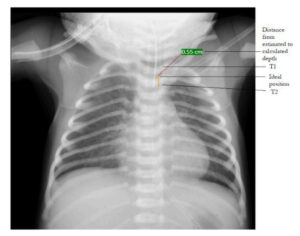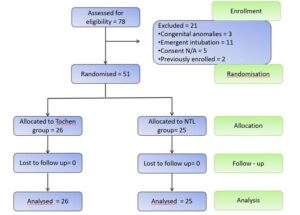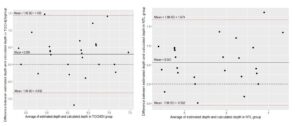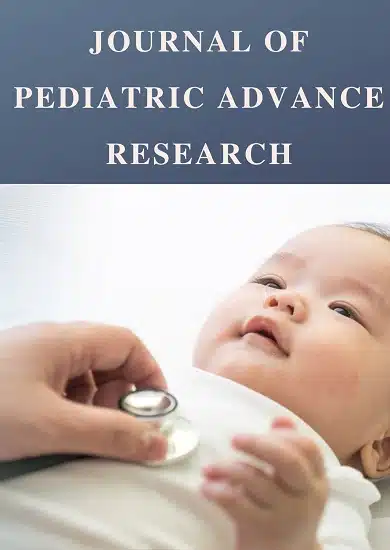Research Article | Vol. 4, Issue 1 | Journal of Pediatric Advance Research | Open Access |
Nasotragal Length or Tochen for Endotracheal Tip Trial
Siddharth Madabhushi1, Chandra Kumar Natarajan1*, Vaanathi Hementha Kumar1, Kanimozhi CV2, Arumugom Archana1
1Department of Neonatology, Kanchi Kamakoti CHILDS Trust Hospital, Chennai, India
2Department of Radiology, Kanchi Kamakoti CHILDS Trust Hospital, Chennai, India
*Corresponding author: Chandra Kumar Natarajan, Head of Department and Senior Consultant, Department of Neonatology, Kanchi Kamakoti CHILDS Trust Hospital, Chennai, India; Email: [email protected]
Citation: Madabhushi S, et al. Nasotragal Length or Tochen for Endotracheal Tip Trial. J Pediatric Adv Res. 2025;4(1):1-8.
Copyright© 2025 by Madabhushi S, et al. All rights reserved. This is an open access article distributed under the terms of the Creative Commons Attribution License, which permits unrestricted use, distribution, and reproduction in any medium, provided the original author and source are credited.
| Received 24 December, 2024 | Accepted 27 January, 2025 | Published 05 February, 2025 |
Abstract
Purpose: The optimal method to estimate ideal depth of insertion of endotracheal tube in neonates is still under question. With increasing evidence that TOCHEN formula is unreliable in ELBW neonates, it is being replaced by Nasotragal Length (NTL) based formulae and standardized weight-based charts.
Objective: (i) To compare NTL (NTL+1 cm) and TOCHEN formula (weight in kg + 6)
Methods: This is a Randomized controlled trial conducted at a Level 3 Neonatal Intensive Care Unit (NICU). 51 neonates who required invasive ventilation were enrolled. The endotracheal tube was fixed at the estimated depth using either the NTL or Tochen formula. A radiograph was taken with the head stabilized in the neutral position within 2 hours of intubation for ascertaining ETT position. A single radiologist blinded to study groups evaluated chest X-rays for ETT position.
Results: TOCHEN group appeared to have a higher proportion (65.4%) of neonates with appropriate ETT position compared to the NTL group (44%) [0.65 (0.29 – 1.42)]. Both methods appear to fare worse in extremes of gestational age (<28 wks and > 38 wks) and birth weight (<1000 gms and >3000 gms)
Conclusion: Our study showed higher appropriate ETT tip placements with TOCHEN formula.
Keywords: Neonatal Ventilation; TOCHEN Formula; Nasotragal Length; Ideal Position; Endotracheal Tube
Introduction
Endotracheal intubation is one of the most common and lifesaving procedures performed in the NICU. Although it is a lifesaving procedure, it is not without potential risks, especially if incorrectly placed [1]. Emergent intubations subjected to an X-ray showed nearly 50% of ET tips were at an improper location [2]. An improperly placed Endotracheal Tube (ETT) may not only result in ineffective ventilation, laryngeal trauma and pneumothorax, but also increases the risk of unplanned reintubations [3]. Checking the position on CXR may not always be feasible in an emergency setting like surfactant administration in delivery room or during the retrieval and transport of a sick newborn [4]. The ideal position of the ETT tip, often quoted is the mid trachea, which usually corresponds to the T1 vertebra and is above the level of the carina [5]. The most common method used for calculating the depth of ETT insertion has been the Tochen formula, a prediction equation formulated in 1979 [6]. The estimated depth calculated was 1.17 multiplied by the neonate’s weight (in kg) plus 5.58 which was later simplified and popularized by the American Academy of Pediatrics as the 7-8-9 rule: a 1-kg neonate is intubated to a depth of 7 cm, a 2-kg neonate to a depth of 8 cm and a 3-kg neonate to a depth of 9 cm [7]. However, the 2015 update to the NRP (Neonatal Resuscitation Program) changed the recommendation from the Tochen formula to the NTL and standardized weight-based charts in the delivery room [8].
In addition, with increasing data that suggest racial differences in depth calculations, race specific formulae are being considered, with some countries that are looking to replace TOCHEN formula for estimating ETT tip depth. However, identifying the correct depth of insertion still remains a challenge. Hence, we designed this trial to study the appropriate method for estimation of depth of insertion of ET tube.
Methodology
The study was a randomized controlled trial conducted at a Level III NICU in India between Jan 2021 to Nov 2021. The trial was registered with CTRI (CTRI/2021/02/030914). Scientific committee and ethics committee approval obtained Reg No. ECR/676/Inst/TN/2014/RR-20.
The aim of our study was to compare the appropriate endotracheal tube placement in neonates with two different methods – Nasotragal length (NTL+1 cm) and Tochen formula (wt+6 cm). The primary outcome was to identify proportion of neonates with optimally positioned endotracheal tube tip on a chest X-ray taken within 2 hours of endotracheal intubation. The secondary outcomes were to identify the proportion of neonates with ETT tip above T1 vertebra, Proportion of neonates with ETT tip below T2 vertebra, Proportion of neonates requiring ETT repositioning (advancement or withdrawal) following chest X-ray, Comparison of estimated depth to calculated depth between the two groups and comparison of alternate formulae viz. NTL + 0.25 cm, NTL + 0.5cm and NTL + 0.75 cm with the calculated endotracheal depth on CXR.
Based on previous data from an RCT by Uygur O, et al., and our own unpublished data, the ETT tip was correctly positioned in approximately 50% of cases [9]. We aimed to reduce incorrectly positioned ETT placement from 50% to 25%. Taking a Power 80%, Alpha error 5%, The total sample size calculated was 116. All neonates requiring invasive ventilation during the study period were enrolled. The neonates who were admitted to the NICU, fulfilling the inclusion criteria were enrolled in the study. Neonates with major congenital anomalies, major vertebral anomalies, emergent intubation where prior randomization or parental consent was not feasible and neonates who were previously enrolled in the study who required reintubation were excluded from the study. Informed consent was obtained from the parents.
A detailed structured proforma which included demographic data, risk factors and investigations were documented electronically (Microsoft Excel™) and was retrieved later for analysis. Prior to endotracheal intubation, the neonates were randomized to either the NTL group or the Tochen formula group. Randomization was done with computer-based sequence generation variable block randomization and parallel assignment with allocation ratio of 1:1. Allocation concealment was done using Sequentially Numbered Opaque Sealed Envelopes (SNOSE) technique. Blinding was not possible due to nature of the intervention. However, the outcome assessor and the consultant radiologist were blinded to the method used to calculate depth of ETT insertion.
The ideal depth was defined as the midpoint between upper border of T1 and lower border of T2. The estimated depth was defined as the depth of insertion calculated based on formulae. The measured depth was defined as the depth of insertion as ascertained from the radiograph taken within 2 hours of insertion. The endotracheal tube was fixed at the estimated depth using either the Nasotragal length (I group) or Tochen formula (C group). The NTL method uses a calculation based on the distance (cm) from the baby’s nasal septum to the ear tragus using a non-stretchable measuring tape to measure the NTL, with the estimated insertion depth (cm) being NTL+1 cm. In the Tochen group, ETT depth was estimated by taking the neonates’ weight in kg within the last 24 hours and adding 6 cm. In both groups, measurements were recorded in centimeters and millimeters without rounding off the value. The depth of insertion in both methods could result in fractional values which could potentially make fixation complicated since ETT lengths are given in measurements of 0.5 cm. Hence it was decided a priori that values up to 1 mm or 2 mm would be rounded off to the nearest zero and values with 3 mm and 4 mm would be rounded off to the nearest 0.5 cm marking. All babies were intubated with a portex based ETT (Smiths medical International, UK). After intubation, the ETT was stabilized to the lateral aspect of the upper lip using with adhesive bandage Dynaplast® surrounding the ETT. The neck was stabilized in neutral position. A portable chest radiograph with digitalized measurements was obtained to document the ETT position within 2 hours of the ETT placement. Just before obtaining the film, the physician on call would re-confirm that the endotracheal tube is secured in a standardized manner at the calculated depth based on the treatment arm assigned. An ideal depth was defined as the ETT tip between upper border of T1 and lower border of T2. Reintubation/ Repositioning maybe performed if the ETT was inappropriate i.e., either above T1, below T2 or depending on the decision of the on-call clinician. If the ETT is being repositioned based on the distance measured digitally, a repeat X-ray was not repeated to avoid unnecessary radiation exposure. A single consultant radiologist, who was blinded to the study groups evaluated chest X-rays and identified if appropriate ET tip placement was achieved.
The distance between the said ideal position and the measured ETT tip on the radiograph was digitally measured using the hospital Picture Archiving and Communication System (PACS) (Fig 1). In addition, we compared the estimated depth to calculated depth between the two groups. We compared calculated depth based on alternate formulae viz. NTL + 0.25 cm, NTL + 0.5 cm and NTL + 0.75 cm, wt+5 cm and wt+5.5 cm to gauge if they were superior in neonates of Indian ethnicity. All neonates who received their allocated treatment were followed until death or hospital discharge and their data were analyzed using the ‘intention-to-treat’ principle.
Statistical Analysis
Descriptive analysis was carried out by frequency and proportion for categorical variables. Mean (±standard deviation) or median (IQR) was used to represent continuous variables. Chi square test was used to test statistical significance of cross tabulation between categorical variables. In case of zero or low frequency in some of the categories, simulated p-value was calculated wherever required. Independent t-test or its non-parametric alternative Mann-Whitney U test was used to compare continuous variables between two groups. Kruskal-Wallis test was used to compare spread of continuous variables between more than two groups. Agreement between estimated and calculated values (depth) was assessed by Bland-Altman analysis. Mean difference with SD, Level of Agreement (LoA) and range were calculated. Association between two continuous variables was assessed by Pearson correlation coefficient. P value < 0.05 was considered statistically significant. RStudio Version 1.2.1093 was used for statistical analysis.

Figure 1: Calculating distance of ETT tip placement from the ideal position from Picture Archiving and Communication System (PACS).
Results
A total of 78 neonates were eligible for the study during the study period. 27 neonates were excluded; 10 had been intubated prior to admission to the NICU, 8 neonates missed randomization, 6 neonates required emergent intubations and could not be randomized for the same and 3 neonates had congenital anomalies. Thus 51 neonates were enrolled in the study; The endotracheal tube was fixed at the lip level using either the Tochen formula (n=26) or the NTL+1cm formula (n=25). The participant flow diagram is shown in Fig 2.
The baseline neonatal characteristics are summarized in Table 1. With 9 extreme preterms (17.6%) included in the study, the NTL group had a baseline mean gestational age (31.12±4.84 vs 34.81±4.74) and birth weight (1657.60±850.21 vs 2251.15±1021.14) that was lower than the TOCHEN group. The other neonatal characteristics were however similar in both groups. The maternal characteristics were similar between the two groups.
The TOCHEN group had a higher proportion (17; 65.4%) of neonates with appropriate ETT position compared to the NTL group (11; 44%) however the difference was not statistically significant (p = 0.277). Irrespective of the method employed, appropriate tube position was achieved only in 54% of neonates (28/52). Both methods appear to fare worse in extremes of gestational age (<28 w and >38 w) and birth weight (<1000 gms and >3000 gms) (Table 2) although not statistically significant.
Overall, among the inappropriate placements of the ETT tip, there were more deeper placements compared to shallow in both arms with only one such instance in the NTL arm and two instances in the TOCHEN arm. Among those with deeper placements, there was a higher rate of the ETT tip below T2 particularly <34 weeks by the NTL when compared to TOCHEN method (36% vs 11.5%). A total of 21% (n=11) of neonates needed repositioning of ETT tip after studying the chest x ray which was taken within 2 hours of intubation. The need for repositioning was more in the NTL group (32%(n=8)) when compared to the TOCHEN arm (11.5% (n=3) although this was not statistically significant. The median (IQR) distance (cm) from mid trachea in NTL group and TOCHEN group was 0.42 (0.20 – 0.95) and 0.335 (0.000 – 0.550); p-value 0.174. Although not statistically significant the estimated depth using TOCHEN method was closer to the ideal position more often than with the NTL method. When the data was stratified by gestational age and birth weight, the estimated distance from the ideal position was further away from the ideal mid-tracheal position in the extremes of gestation (<28 weeks and >38 weeks) and with extremes of birth weight (<1000gms and >3000 gms) (Table 2).
The mean difference between estimated depth and ideal depth in both the groups group was analysed by Bland Altman analysis. It was found to be 0.561 with Level of Agreement (LoA) ranging from -0.552 to 1.674 in the NTL group. The mean difference between estimated depth and ideal depth in TOCHEN group was found to be 0.299 with Level of Agreement (LoA) ranging from -0.832 to 1.430 (Fig 3). In addition, the mean difference with NTL+0.5 was 0.057±0.601 which was found to be less compared to the traditional NTL+1 formula (Table 3).

Figure 2: Participant flow chart.

Figure 3: Bland Altmann analysis of mean difference between estimated depth and ideal depth in TOCHEN group and NTL group.
Baseline Characteristics | NTL (n=25) | TOCHEN (n=26) | P-value |
Gestational Age (weeks)a | 31.12±4.84 | 34.81±4.74 | 0.008 |
Birth weight (g)a | 1657.60±850.21 | 2251.15±1021.14 | 0.029 |
Sexb ● Male ● Female | 17(68) | 16(61.5) | 0.629 |
8(32) | 10(38.5) | ||
Survivalb ● Died ● Survived | 7(28) | 5(19.2) | 0.460 |
18(72) | 21(80.8) | ||
Intubation Typeb ● Intubation ● Re-intubation | 12(48) | 9(34.6) | 0.332 |
13(52) | 17(65.4) | ||
Age at inclusionc | 4(1,8) | 5(2,11) | 0.499 |
Table 1: Baseline neonatal characteristics of both groups (amean±SD,bn(%), cMedian (IQR).
| NTL (n=11) | TOCHEN (n=17) | P-value |
Gestational age (weeks) | |||
<28 | 3 (27.3) | 1 (5.9) | 0.096 |
28 to 34 | 5 (45.5) | 4 (23.5) | |
35 to 38 | 3 (27.3) | 8 (47.1) | |
>38 | 0 (0) | 4(23.5) | |
Birth weight (g) | |||
<1000 | 3(27.3) | 2(11.8) | 0.332 |
1000 to 2000 | 5(45.5) | 6(35.3) | |
2001 to 3000 | 3(27.3) | 4(23.5) | |
>3000 | 0(0) | 5(29.4) | |
Table 2: Comparison based on gestational age and birth weight between NTL and TOCHEN group for neonates with appropriate position of endotracheal tube.
Variables | Mean Difference ± SD | LoA | Range |
Estimated depth and calculated depth in NTL (+0.25) group | -0.193±0.601 | -1.371;0.985 | 2.356 |
Estimated depth and calculated depth in NTL (+0.50) group | 0.057±0.601 | -1.121;1.235 | 2.356 |
Estimated depth and calculated depth in NTL (+0.75) group | 0.307±0.601 | -0.871;1.485 | 2.356 |
Table 3: Bland Altman analysis between hypothetical estimated depth and calculated depth in NTL group.
Discussion
In our study a total of 51 neonates were included. Overall, irrespective of the method used, there was appropriate ETT tip placement in only 54.9% of neonates. While disappointing, it is not surprising since this is comparable to what is described in literature where it ranges between as low as 14% by Chung, et al., to 55% by Flinn, et al., when the satisfactory tip position was taken as between T1-T2 as in our study [10,11]. An Indian study by Tatwavedi, et al., in 2014 had a much higher adequate tip position of 60% due to their definition being between T1- T4 [12]. However, when looking at optimal depth between T1 and T2, it reduced significantly to 14%.
A Turkish study by Uygur O, et al., conducted an RCT similar to ours comparing TOCHEN and NTL found that ETT was placed below T2 at a higher rate in infants, particularly with a gestational age of <34 weeks [9]. Most clinicians tend to accept ETT positions around T3 and T4 as long as the tip is above the carina and avoid excessive tube manipulation due to fear of accidental Extubation and increase in pneumothorax [13]. A study by Thayyil, et al., observed a 25% adverse outcome such as single lung ventilation, lobar collapse, non-uniformed aeration or pneumothorax even if the tube placement is suboptimal by even one or two vertebral bodies particularly in the extremely premature neonate [14]. In spite of a high inappropriate tube placement, we observed no adverse pulmonary outcomes mentioned above in either of the 2 arms.
The high number of inappropriate tube placements did not translate to a similar number of ETT repositions in our study with only half of those needing a repositioning (21.5% [11/51]). It was also observed that 32% infants needed endotracheal tube repositioning in NTL group and 11.5% infants needed endotracheal tube repositioning in TOCHEN group, although this was not statistically significant. The frequency of reposition is higher in studies where the majority of the study population were extreme preterms and this likely the reason why our frequency of repositioning was much lesser.
The degree of malposition also appears to be higher in the NTL group, but this could due to the skewed baseline characteristics with the NTL, with an overall reduced mean gestation and weight in spite of randomization due to the study being underpowered with the current sample size. To circumvent this concern in this gestation, studies have called for different formulae for different gestations instead of a single universal formula. Puttawong D, et al., suggested that when using NTL for depth estimation, NTL+1 if NTL was <6.5 cm and NTL+0.5 if NTL > 6.5 cm provided more accuracy in estimating ideal insertion depth [15]. In our study, NTL+0.5 also had a better level of agreement to the calculated depth, irrespective of the calculated NTL. Wang, et al., suggested NTL+1 for neonates < 2500 gms and NTL+0.5 for those > 2500 gms [16].
What is Already Known?
Various methods have been implicated in estimating ideal depth of insertion of ETT in neonates but the optimal method to estimate ideal depth of insertion of the endotracheal tube in the neonate is still under question.
What This Study Adds?
It is the first RCT from India comparing two commonly used methods for depth of insertion of ETT, adding more literature and understanding the racial differences and therefore the applicability of these formulae in Indian context.
For Indian neonates, use of TOCHEN formula results in higher appropriate ETT tip placements with reduced need for tube repositioning when compared to NTL+1.
NTL+0.5 may be more suitable in Indian neonates than NTL+1.
Conclusion
Our study showed that there is a trend towards higher appropriate ETT tip placements with reduced need for tube repositioning with TOCHEN formula as compared to NTL formula but needs to be confirmed in larger trials.
Conflict of Interests
The authors have no conflict of interest to declare.
Consent of Patient
Informed consent has been taken from the parent to publish any medically relevant images of their child ensuring the anonymity of the identity.
Author’s Contribution
Siddharth Madabhushi, Chandra Kumar Natarajan, Vaanathi Hementha Kumar and Kanimozhi C V were involved in management of the patient. Siddharth Madabhushi and Arumugom Archana reviewed the literature and drafted the manuscript. Chandra Kumar Natarajan critically revised the manuscript. All authors approved the final manuscript as submitted.
References
- Sawyer T, Foglia E, Hatch LD. Improving neonatal intubation safety: A journey of a thousand miles. J Neonatal Perinatal Med. 2017;10:125-31.
- Kuhns LR, Poznanski AK. Endotracheal tube position in the infant. J Pediatr. 1971;78:991-6.
- Thayyil S, Chandrasekaran M, Taylor A. Cerebral magnetic resonance biomarkers in neonatal encephalopathy: A meta-analysis. Pediatrics. 2010;125:e382-95.
- O’Donnell CPF, Kamlin COF, Davis PG. Endotracheal intubation attempts during neonatal resuscitation: success rates, duration and adverse effects. Pediatrics. 2006;117:e16-21.
- Blayney M, Costello S, Perlman M. A new system for location of endotracheal tube in preterm and term neonates. Pediatrics. 1991;87:44-7.
- Tochen ML. Orotracheal intubation in the newborn infant: a method for determining depth of tube insertion. J Pediatr. 1979;95:1050-1.
- Niermeyer S, Kattwinkel J, Van Reempts P. International guidelines for neonatal resuscitation: an excerpt from the guidelines 2000 for cardiopulmonary resuscitation and emergency cardiovascular care: international consensus on science. contributors and reviewers for the neonatal resuscitation guidelines. Pediatrics. 2000;106:E29.
- Kempley ST, Moreiras JW, Petrone FL. Endotracheal tube length for neonatal intubation. Resuscitation. 2008;77:369-73.
- Uygur Ö, Öncel MY, Şimşek GK. Is nasal septum-tragus length measurement appropriate for endotracheal tube intubation depth in neonates? A randomized controlled study. Am J Perinatol. 2021;38:728-33.
- Chung N, Kim Y, Park E. An integrative review of family interventions based on a philosophy of family-centered care in neonatal intensive care units. Perspect Nurs Sci. 2019;16:35-44.
- Flinn AM, Travers CP, Laffan EE. Estimating the endotracheal tube insertion depth in newborns using weight or gestation: a randomised trial. Neonatol. 2015;107:167-72.
- Tatwavedi D, Nesargi SV, Shankar N. Evaluation of body parameters for estimation of endotracheal tube length in Indian neonates. Eur J Pediatr. 2015;174:245-9.
- Yu VY, Wong PY, Bajuk B. Pulmonary air leak in extremely low birthweight infants. Arch Disease in Childhood. 1986;61:239-41.
- Thayyil S, Nagakumar P, Gowers H. Optimal endotracheal tube tip position in extremely premature infants. Am J Perinatol. 2008;25:13-6.
- Puttawong D, Manopunya S, Visrutaratna P. Accuracy of various recent recommendations to estimate the optimal depth of orotracheal tube in Thai neonates. J Matern Fetal Neonatal Med. 2022;35:3343-7.
- Wang TC, Kuo LL, Lee CY. Utilizing nasal-tragus length to estimate optimal endotracheal tube depth for neonates in Taiwan. Indian J Pediatr. 2011;78:296-300.
Author Info
Siddharth Madabhushi1, Chandra Kumar Natarajan1*, Vaanathi Hementha Kumar1, Kanimozhi CV2, Arumugom Archana1
1Department of Neonatology, Kanchi Kamakoti CHILDS Trust Hospital, Chennai, India
2Department of Radiology, Kanchi Kamakoti CHILDS Trust Hospital, Chennai, India
*Corresponding author: Chandra Kumar Natarajan, Head of Department and Senior Consultant, Department of Neonatology, Kanchi Kamakoti CHILDS Trust Hospital, Chennai, India; Email: [email protected]
Copyright
Siddharth Madabhushi1, Chandra Kumar Natarajan1*, Vaanathi Hementha Kumar1, Kanimozhi CV2, Arumugom Archana1
1Department of Neonatology, Kanchi Kamakoti CHILDS Trust Hospital, Chennai, India
2Department of Radiology, Kanchi Kamakoti CHILDS Trust Hospital, Chennai, India
*Corresponding author: Chandra Kumar Natarajan, Head of Department and Senior Consultant, Department of Neonatology, Kanchi Kamakoti CHILDS Trust Hospital, Chennai, India; Email: [email protected]
Copyright© 2025 by Madabhushi S, et al. All rights reserved. This is an open access article distributed under the terms of the Creative Commons Attribution License, which permits unrestricted use, distribution, and reproduction in any medium, provided the original author and source are credited.
Citation
Citation: Madabhushi S, et al. Nasotragal Length or Tochen for Endotracheal Tip Trial. J Pediatric Adv Res. 2025;4(1):1-8.



